15 Chapter Fifteen: Menu Planning and Food Safety
Chapter 15 Learning Objectives
By the end of this chapter, you should be able to:
- Outline the meal patterns for infants and children.
- Create nutritious menus that follow the meal patterns.
- Describe factors to consider when menu planning.
- Identify a variety of sources of food for each food group.
- Examine individual and cultural food preferences.
- Discuss the benefits of family style meal service.
- Relate ways to support families in providing well-balanced foods from home.
- Outline important considerations for buying, storing, preparing, cooking, and serving food safely.
Introduction
Knowledge of menu planning is essential to providing appropriate nutrition to young children. Early care and education programs must have staff who plan and prepare food that are aware of individual preferences, including vegetarianism, and cultural and religious differences in food choice, preparation, and service. To protect children’s health, proper hygiene and sanitation processes must be followed closely. Only safe food should be purchased. And how that food is stored, prepared, and served must follow proper protocol to prevent foodborne illness.
Menu Planning
Let’s examine several factors that are important for menu planning, including the meal patterns, licensed programs must follow, the importance of variety and balance, and aesthetics.
Meal Patterns
In the state of California, licensing requires programs to follow the meal plan requirements of the Child and Adult Care Food Program and the Healthy Beverages in Child Care Act. Both of these were introduced in Chapter 12. To review, here are the breakfast meal patterns for infants and children.
Breakfast
Table 15.1 – Infant Breakfast Meal Patterns [1]
| Meal or snack | 0-5 Months | 6-11 Months |
| Breakfast | 4-6 fl oz breastmilk or formula | 6-8 fl oz breastmilk or formula
0-4 tbsp infant cereal, meat, fish, poultry, whole eggs, cooked dry beans or peas; or 0-2 oz cheese; or 0-4 oz (volume) cottage cheese; or 0-4 oz yogurt; or a combination* 0-2 tbsp vegetable, fruit or both* |
Solid foods are required when the infant is ready. All serving sizes are minimum quantities of the food components that are required to be served.
Table 15.2 – Breakfast Meal Pattern for Children [2]
| Food Item | 1-2 Years | 3-5 Years | 6-18 Years |
|
Milk |
½ cup whole | ¾ cup low-fat or fat-free | 1 cup low-fat or fat-free |
| Vegetables, fruit, or both | ¼ cup | ½ cup | ½ cup |
| Grains | ½ ounce equivalent | ½ ounce equivalent | 1 ounce equivalent |
Here is what breakfasts that follow the meal pattern might look like:
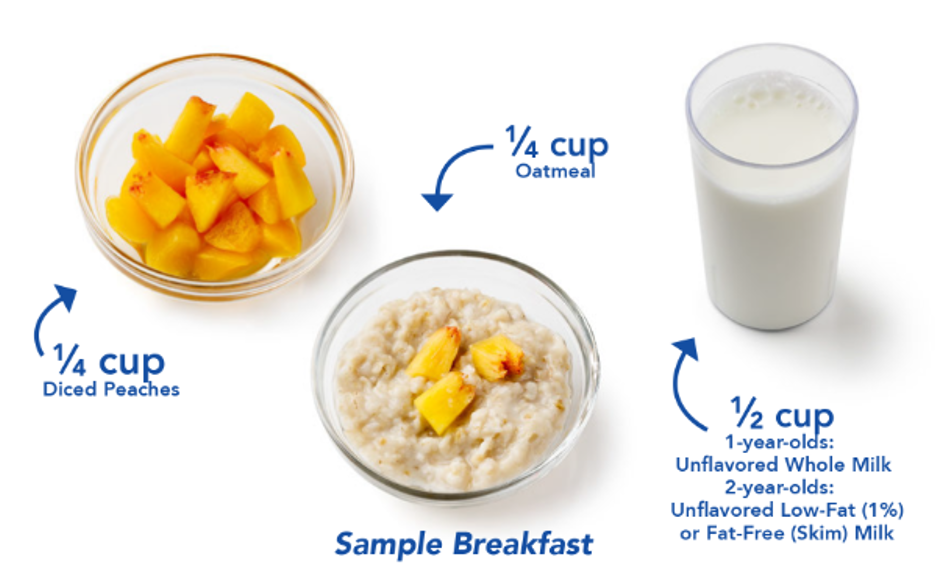
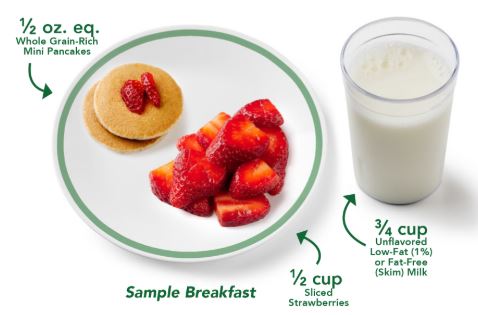
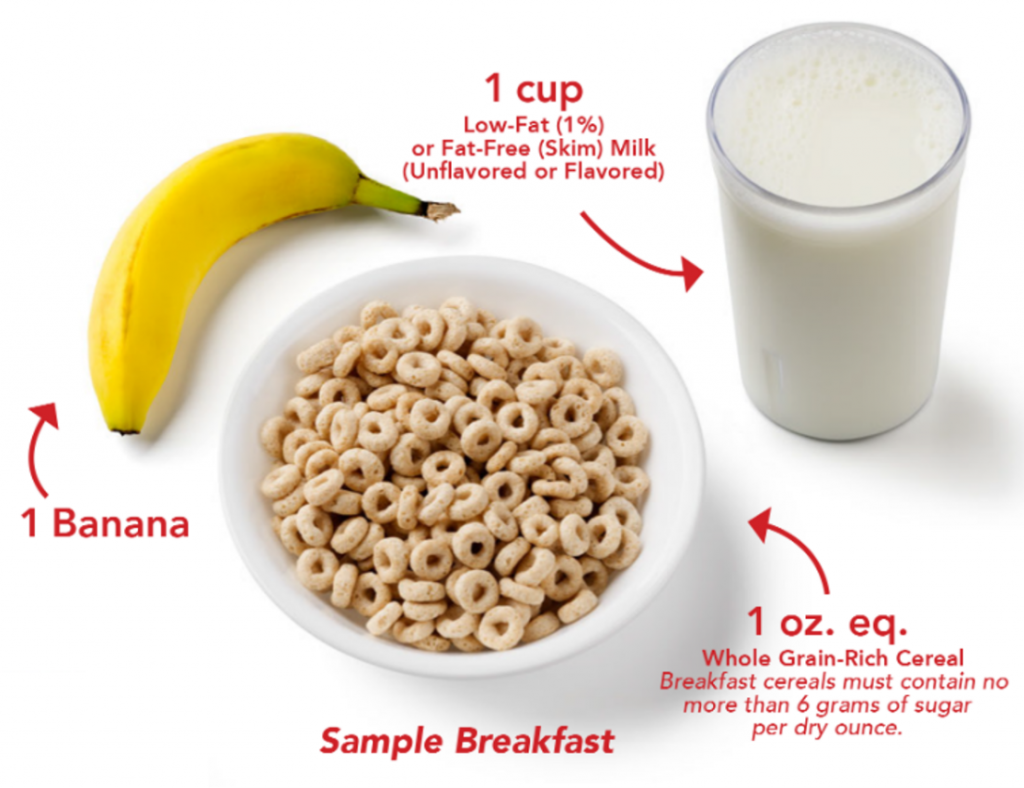
Pause to Reflect
 |
Create your own breakfasts that follow the meal plan for each age. |
Lunch
And here are the lunch meal patterns for infants and children:
Table 15.3 – Infant Lunch Meal Patterns [6]
| Meal or snack | 0-5 Months | 6-11 Months |
| Lunch or Supper | 4-6 fl oz breastmilk or formula | 6-8 fl oz breastmilk or formula
0-4 tbsp infant cereal, meat, fish, poultry, whole eggs, cooked dry beans or peas; or 0-2 oz cheese; or 0-4 oz (volume) cottage cheese; or 0-4 oz yogurt; or a combination*
0-2 tbsp vegetable, fruit or both*
|
Solid foods are required when the infant is ready. All serving sizes are minimum quantities of the food components that are required to be served
Table 15.4 – Lunch Meal Pattern for Children [7]
| Food Item | 1-2 Years | 3-5 Years | 6-18 Years |
| Milk | ½ cup whole | ¾ cup low-fat or fat-free | 1 cup low-fat or fat-free |
| Meat and meat alternative | 1 ounce | 1½ ounces | 2 ounces |
| Vegetables | 1/8 cup | ¼ cup | ½ cup |
| Fruits | 1/8 cup | ¼ cup | ¼ cup |
| Grains | ½ ounce equivalent | ½ ounce equivalent | 1 ounce equivalent |
Here is what lunches that follow the meal pattern might look like:
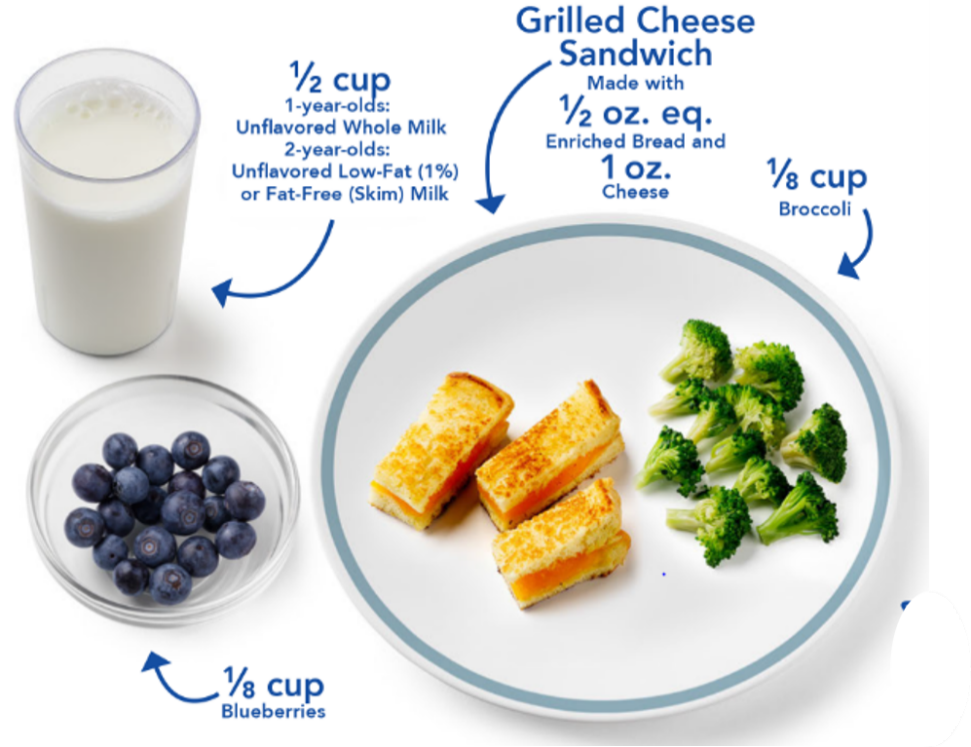
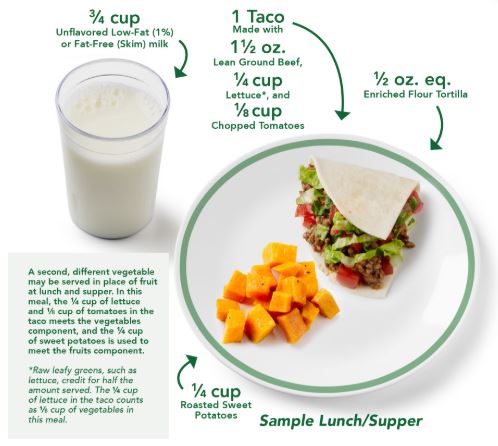
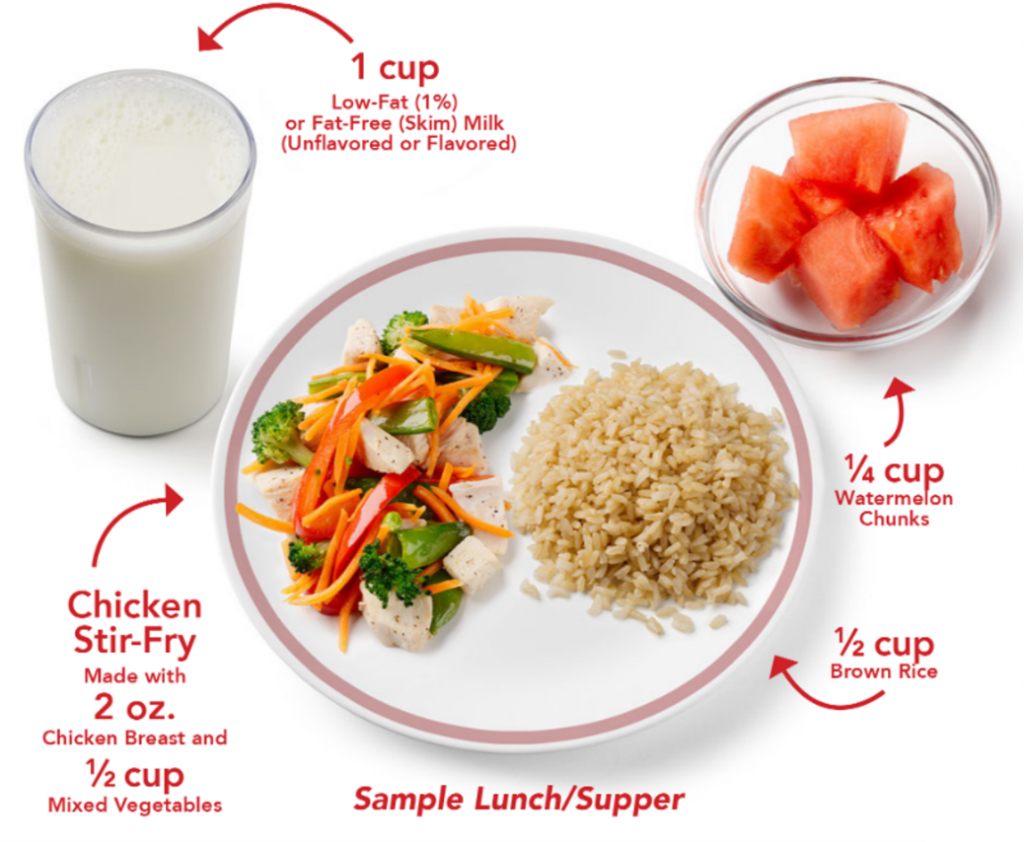
Pause to Reflect
 |
Create your own lunches that follow the meal plan for each age. |
Snacks
And finally, here are the meal patterns for snacks for infants and children:
Table 15.5 – Infant Snack Meal Patterns [11]
| Meal or snack | 0-5 Months | 6-11 Months |
| Snack | 4-6 fl oz breastmilk or formula | 2-4 fl oz breastmilk or formula
0-½ bread slice; or 0-2 crackers; or 0-4 tbsp infant cereal or ready-to-eat cereal* 0-2 tbsp vegetable, fruit or both* |
Solid foods are required when the infant is ready. All serving sizes are minimum quantities of the food components that are required to be served.
Table 15.6 – Snack Meal Pattern for Children [12]
| Food Item | 1-2 Years | 3-5 Years | 6-18 Years |
| Milk | ½ cup whole | ½ cup low-fat or fat-free | 1 cup low-fat or fat-free |
| Meat and meat alternative | ½ ounce | ½ ounce | 1 ounce |
| Vegetables | ½ cup | ½ cup | ¾ cup |
| Fruits | ½ cup | ½ cup | ¾ cup |
| Grains | ½ ounce equivalent | ½ ounce equivalent | 1 ounce equivalent |
Best practice: Make at least 1 of the 2 required components of a snack a vegetable or a fruit. [13]
Here are some snacks that follow the meal pattern:
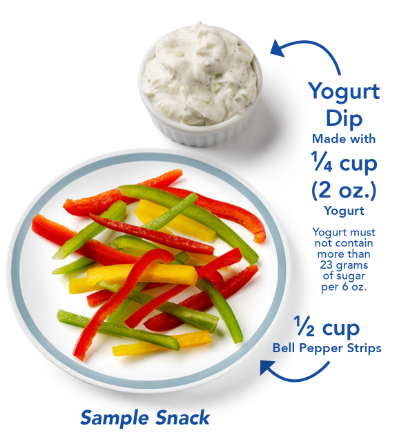
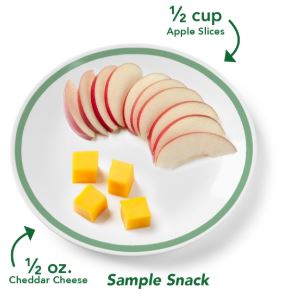
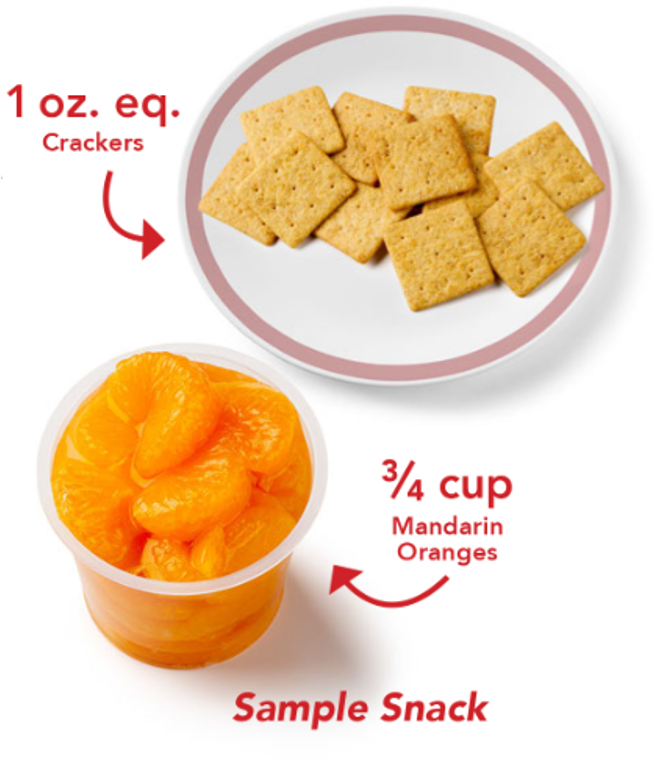
Pause to Reflect
 |
Create your own snacks that follow the meal plan for each age. |
Factors to consider
Menu planning principles include aesthetics, and variety, including color, texture, flavors, shapes, and sizes of food, cost, balance, and nutritional quality, The availability of equipment and staff knowledge and skill to prepare the foods on menus are also important considerations in planning the menu. Along with all of these, an effective menu also considers cost.[17]
Aesthetics and Variety
How our food is presented, along with texture, consistency, color, shape, and the preparation method, influences how we feel and what we think about a menu. It can even influence our appetite and our interest in eating.[18]
Select nutritious foods that are contrasting colors and textures. This adds to the visual and chewing appeal. Try to vary the colors of the foods being served. Avoid serving foods that are all one color. For example, select a green, soft vegetable (spinach), a red, crunchy fruit (an apple), and colorful, chewy wild rice to go along with a piece of chicken and a glass of milk. This lends visual and chewing appeal as the children can see different colors and feel different textures as they chew.[19]
Pause to Reflect
 |
Go back and look at the samples. How well do you think they did with creating meals and snacks that offered variety and were visually appealing? What about the versions you created? |
Cost
While well-balanced nutrition should never be sacrificed to save money, early care and education programs must also consider the costs of the menus they plan. One way to save costs is to use cycle menus. A cycle menu follows a particular pattern and repeats on a regular basis. The length of the cycle can vary, but may be 4-6 weeks long and can be different lengths for different meals/snacks (for instance, with breakfast repeating more often than lunches). And they can be updated as needed to include new foods or make other accommodations.[20]
Cycle menus allow a program to forecast costs, order in bulk, and reduce waste (with tried and tested menus). Cycle menus are often planned seasonally so an operation might have a spring, summer, and fall/winter cycle.[21] And buying produce seasonally is often more affordable.
Nutrition and Balance
The most important consideration for menu planning is that it meets children’s nutritional needs. The meals and snacks provided by full-day early care and education program should provide a substantial portion of a child’s daily nutrition. All programs should be supporting children’s well–balanced diet, in which all the nutrients the body needs for proper functioning and energy are taken in. A well-balanced diet contains a variety of foods from all the food groups, as well as all the necessary vitamins and minerals we need. It also means taking in an adequate supply of water for adequate health. A well-balanced diet can be planned by selecting healthy foods from each of the food groups.[22]
Food Groups
Let’s look at each of the food groups a bit more closely and identify sources for each.
Dairy Group
All fluid milk products and many foods made from milk are considered part of this food group. Foods made from milk that retain their calcium content are part of the group. Foods made from milk that have little to no calcium, such as cream cheese, cream, and butter, are not. Calcium-fortified soymilk (soy beverage) is also part of the Dairy Group. When choosing dairy, fat-free and low-fat dairy are good options for children.[23]

Sources of dairy include:
- Milk (low fat, fat-free, whole)
- Lactose-free and lactose-reduced milk
- Yogurt
- Pudding
- Ice cream
- Frozen yogurt
- Calcium-fortifiedsoy milk
- Hard cheeses (cheddar, mozzarella, swiss, parmesan)
- Soft cheeses (ricotta, cottage cheese)
- Calcium-fortified juices and cereals[25]
Tips for Serving the Dairy Group for Children
· Serve unflavored, fat-free, and low-fat milks most often. They have less added sugar and fewer calories than flavored, whole, or reduced-fat milk.
· Low-fat milk, yogurt, and cheese provide much needed calcium. Try making a dip for fruits or vegetables from yogurt.
· Blend dairy into smoothies. Combine low-fat or fat-free yogurt with bananas and cocoa powder for a smoothie, or try milk, ice cubes, and frozen berries.[26]
Protein Group
All foods made from meat, poultry, seafood, beans and peas, eggs, processed soy products, nuts, and seeds are considered part of the Protein Foods Group. Select a variety of protein foods to improve nutrient intake and health benefits, including cooked seafood. Meat and poultry choices should be lean or low-fat.[27]

Sources of protein include:
- Beef
- Pork (ham, pork chops)
- Lamb
- Veal
- Poultry (chicken, turkey)
- Beans (black, kidney, chickpeas, lentils, navy, pinto, white, soy beans, split peas)
- Eggs
- Canned fish (sardines, salmon, tuna, anchovies, clams)
- Fish (cod, tuna, sea bass, catfish, flounder, halibut, swordfish, trout, mackerel)
- Shellfish (shrimp, lobster, crab, mussels, oysters, scallops)
- Nuts (almonds, walnuts, hazelnuts, pistachios, peanuts, pecans)
- Seeds (sesame, pumpkin, squash, sunflower)[29]
Tips for Serving the Protein Group for Children
· Choose a variety of protein foods such as seafood, beans, lean meats, poultry, and eggs.
· Limit highly processed poultry, fish, or meat (like hotdogs, chicken nuggets, and fish sticks). Even some “reduced-fat” meats and cold cuts, like sausage, bologna, and salami, may be high in saturated fat and sodium.
· Add beans to children’s favorite foods. Add beans and peas to tacos, casseroles, stews, pastas, and side dishes.[30]
Fruit Group
Any fruit or 100% fruit juice counts as part of the Fruit Group. Fruits may be fresh, canned, frozen, or dried, and may be whole, cut-up, or pureed.[31] Intake of fruit juice should be limited to no more than once a day.
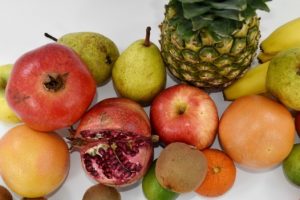
Sources of fruit include:
- Apples
- Apricots
- Bananas
- Blueberries
- Cantaloupe
- Cherries
- Fruit juices (100% fruit juice, all varieties)
- Grapefruit
- Grapes
- Kiwi
- Lemons
- Limes
- Mangoes
- Nectarines
- Oranges
- Papayas
- Peaches
- Pears
- Pineapples
- Plums
- Raisins
- Raspberries
- Strawberries
- Watermelon[33]
Tips for Serving the Fruit Group for Children
· Focus on whole fruits
· Serve a rainbow of choices. Fruit can be a quick and easy way to make meals and snacks healthier and more colorful.
· Choose from fresh, frozen, canned, and dried fruits. Purchase canned fruit in water or 100% fruit juice instead of syrup.
· Limit fruit juice. While 100% fruit juice can be part of a healthy diet, it does not contain the dietary fiber found in other forms of fruit.
· Offer raisins or other unsweetened dried fruit instead of chewy fruit snacks or strips, which usually contain very little fruit. [34]
Vegetable Group
Any vegetable or 100% vegetable juice counts as a member of the Vegetable Group. Vegetables may be raw or cooked; fresh, frozen, canned, or dried/dehydrated; and may be whole, cut-up, or mashed. Based on their nutrient content, vegetables are organized into 5 subgroups: dark-green vegetables, starchy vegetables, red and orange vegetables, beans and peas, and other vegetables. While it is not necessary to eat vegetables from each subgroup daily, over the course of a week, vegetables from each subgroup should be eaten to reach ensure the daily intake recommendation of the different vitamins is met. [35]
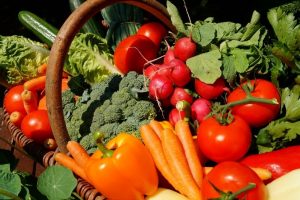
Sources of vegetables include:
- Artichokes
- Asparagus
- Bok choy
- Broccoli
- Celery
- Collard greens
- Corn
- Cucumbers
- Green lima beans
- Green peas
- Lettuce
- Kale
- Mushrooms
- Mustard greens
- Onions
- Peppers (green, red, orange, yellow)
- Potatoes
- Spinach
- Squash (all varieties)
- Sweet potatoes
- Taro
- Tomatoes
- Turnip greens
- Water chestnuts[37]
Tips for Serving the Vegetable Group for Children
· Serve a variety of colorful choices. Brighten children’s plates with red, orange, and dark-green vegetables.
· Choose from fresh, frozen, or canned vegetables. Prepare and serve vegetables without added salt or solid fat.
· Try a dip. Kids love to dip their foods. Whip up a quick dip for veggies with yogurt and seasonings such as herbs or garlic. Serve with raw vegetables like broccoli, carrots, or cauliflower.[38]
· Provide at least one serving each of dark green vegetables, red and orange vegetables, beans and peas (legumes), starchy vegetables, and other vegetables once per week.[39]
Grain Group
Any food made from wheat, rice, oats, cornmeal, barley, or another cereal grain is a grain product. Bread, pasta, breakfast cereals, grits, and tortillas are examples of grain products. Foods such as popcorn, rice, and oatmeal are also included in the Grains Group.
Grains are divided into 2 subgroups: Whole Grains and Refined Grains. Whole grains contain the entire grain kernel ― the bran, germ, and endosperm. Examples of whole grains include whole-wheat flour, bulgur (cracked wheat), oatmeal, whole cornmeal, and brown rice. Refined grains have been milled, a process that removes the bran and germ. This is done to give grains a finer texture and improve their shelf life, but it also removes dietary fiber, iron, and many B vitamins. Some examples of refined grain products are white flour, de-germed cornmeal, white bread, and white rice.
Most refined grains are enriched. This means certain B vitamins (thiamin, riboflavin, niacin, folic acid) and iron are added back after processing. Fiber is not added back to enriched grains. Check the ingredient list on refined grain products to make sure that the word “enriched” is included in the grain name. Some food products are made from mixtures of whole grains and refined grains.[40]
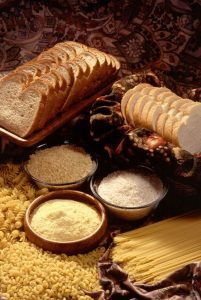
Source of grain include:
- Barley
- Bread (all kinds)
- Bulgur
- Cereals (all kinds)
- Cornbread
- Cornmeal
- Couscous
- Crackers
- Millet
- Muesli
- Oatmeal
- Rice
- Pasta (including whole wheat)
- Popcorn
- Pretzels
- Tortillas[42]
Tips for Providing the Grain Group for Children
· Make at least half their grains whole grains by offering 100% whole-grain cereals, breads, and pasta.
· Vary the choices for whole grains. Rolled oats, oatmeal, brown rice, wild rice, buckwheat, quinoa, wheat berries, and millet are whole-grain foods.
· Choose toppings wisely for toast, hot cereals, pasta, and rice. Instead of adding butter, stick margarine, and regular full-fat cheese, use vegetable oils, low-fat cheeses, or marinara sauce as toppings.[43]
· Provide at least two servings of whole grain-rich grains per day.[44]
Oils
Oils are NOT a food group, although they provide essential nutrients. Oils include items such as butter, oils, margarine, mayonnaise, salad dressings. These food items should be used sparingly. Foods such as fish, nuts, and avocados are good choices of fats. Many foods we eat, especially those that are processed, often are high in fat. This should be considered when planning meals.[45]
Tips for Providing Oils for Children
· Limit serving purchased pre-fried foods to no more than one serving per week.[46]
Individual and Cultural Preferences
What families eat, how those foods are prepared and served, and the routines surrounding meals and snacks are going to vary in every family. For some children, those will be similar to what they encounter in early care and education programs. And some children will easily adapt to new foods and routines. But gathering information from families on these is one way to have an understanding of the food experiences and preferences children have. Menus can be planned that include familiar foods.
Cultural and Religious Considerations
Some people do not eat various specific foods and beverages in conformity with various religious, cultural, legal, or other societal prohibitions. Many of these prohibitions constitute taboos. Many food taboos and other prohibitions forbid the meat of a particular animal. Some food prohibitions can be defined as rules, codified by religion or otherwise, about which foods, or combinations of foods, may not be eaten and how animals are to be slaughtered or prepared. Some foods may be prohibited during certain religious periods (e.g., Lent), at certain stages of life (e.g., pregnancy), or to certain classes of people (e.g., priests), even though the food is otherwise permitted.[47]
Families and children may choose to exclude, include, or prepare foods in a particular way according to their religious faith and beliefs. The guidance given in Table 15.7 on food choices for specific religious groups is very general (and does not include prohibited items, such as alcohol that do not apply to children in early care and education programs). There will be individual differences and varying levels of adherence to guidelines which should be discussed for each child with their family. Some people within some of the faith groups identified may not observe the dietary guidelines listed. Prohibitions and restrictions even within a particular faith may change between denominations or branches.[48]
Table 15.7 – General Guidance for Religious Food Choices [49]
| Religious Affiliation | General Guidelines |
| Buddhist | · Many are vegetarian or vegan
· Some may eat fish or eggs · May participate in fasting |
| Hindu | · Most are vegetarian
· Dairy is usually acceptable · Those who eat meat, poultry, and fish will exclude beef · May fast |
| Jewish | · Pork and pork products are excluded
· Kosher beef, lamb, poultry, and fish (with fins and scales) are eaten · Shellfish are excluded · Meat and dairy are never eaten at same meal; dairy may not be eaten until 3 hours after meat or poultry · Will also exclude gelatin, fats, emulsifiers, stabilizers, and additives from animal origin that Is not kosher · May fast |
| Muslim | · Pork and pork products are excluded
· Halal beef, lamb, poultry, fish are eaten · Dairy products are eaten by most · Will also exclude gelatin, fats, emulsifiers, stabilizers, and additives from animal origin that Is not halal · May fast |
| Sikh | · Many are vegetarian
· Those who eat meat, poultry and fish will exclude beef and possibly pork · Halal and kosher meat are not eaten |
| Rastafarian | · Pork and pork products are excluded
· Many will be vegetarian · Some may be vegan · Prefer to eat a pure and natural diet so may exclude: |
| Seventh-Day Adventist[50] | · Those who eat meat typically do not eat meat from pigs, certain fish, and other animals that the Bible names as unclean
· Many are vegetarian or vegan · Encourage drinking a lot of water |
| Mormon[51] | · Hot drinks containing caffeine are excluded |
Food Allergies, Intolerances, and Medical Issues
As discussed in Chapter 13, some allergic reactions can be life-threatening and some foods can cause major health issues for children, it is vitally important that everyone in the early care and education program that prepares or serves food is aware of these and protects children from consuming food that can hurt them.
Vegetarian Menu Planning
A vegetarian diet does not include any meat, poultry, or seafood. It is a meal plan made up of foods that come mostly from plants. These include:
- Vegetables
- Fruits
- Whole grains
- Legumes
- Seeds
- Nuts
- May include eggs and/or milk if ovo-lacto vegetarian
A vegetarian diet contains no animal proteins. A semi-vegetarian diet is a meal plan that contains little animal protein, but mostly plant-based foods. Vegetarians DO NOT eat:
- Fowl
- Seafood
- Beef
- Pork
- Lamb
- Other animal meats, such as bison, or exotic meats like ostrich or alligator
Vegetarians also do not eat products containing gelatin or rennin (an enzyme found in calf’s stomachs that is used to produce many cheeses).
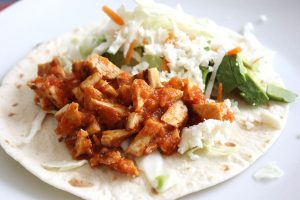
Here are the different types of vegetarian diets:
- Vegan: Includes only plant-based foods. No animal proteins or animal by-products such as eggs, milk, or honey.
- Lacto-vegetarian: Includes plant foods plus some or all dairy products.
- Lacto-ovo vegetarian: Includes plant foods, dairy products, and eggs.
- Semi- or partial vegetarian: Includes plant foods and may include chicken or fish, dairy products, and eggs. It does not include red meat.
- Pescatarian: Includes plant foods and seafood.
Tips for Menu Planning for Children with Vegetarian Diets
When following a vegetarian diet, keep in mind the following:
· Provide different kinds of foods, including vegetables, fruits, beans, nuts, seeds, whole grains, and low-fat or fat-free dairy and eggs if their diet includes these.
· Choose fortified foods, such as cereals, breads, soy or almond milk, and fruits juices to get a full range of nutrients.
· Limit foods that are high in sugar, salt (sodium), and fat.
· Include a protein source with all meals.
· Learn to read the Nutrition Facts Label on food packages. The label tells you the ingredients and nutrition contents of the food product.
· If you follow a more restrictive diet, you may want to work with a dietitian to make sure you are getting enough nutrients.
Note: Vegetarian children may need to take supplements at home if their diet lacks certain vitamins and minerals.[53]
Pause to Reflect
 |
What familiarity do you have with any of the varieties of food preferences (including those that may not have been presented in the book)? |
Family Style Meal Service
Currently, traditional family style meal service is the recommended approach to serving meals in preschool settings. Using this approach, all foods on the menu are served at the same time in serving bowls that are passed around the table, and children self-serve the amounts they desire. There are a number of potential advantages to traditional family-style meal service including allowing children the opportunity to self-regulate consumption (match food selection with hunger level).[54]
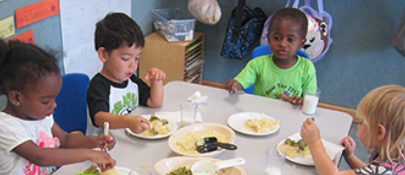
This approach to mealtime creates a number of healthy habits that are important to the growth and development of children at any age. Children tend to eat more healthy foods if they see their friends try it. They learn skills such as taking turns, sharing, and teamwork.
Family style dining opens up opportunities for conversation, which increases vocabulary, promotes proper use of language and interaction with friends.
There are even more benefits that support healthy growth. Children learn:
- portion sizes for each food group
- to recognize when they are hungry or satisfied
- how to identify healthy foods and where they come from
- to improve fine motor skills
Children are not the only ones who benefit. Providers get a better grasp of food costs, get help with mealtime service and, with less food being wasted, they save money.[56]
Tips for Family Style Dining
· Start with the right equipment. When purchasing serving dishes, utensils and other place settings, keep in mind that they need to be kid-friendly and sized for little hands to maneuver
· Remember each child’s skill level when choosing your menu. Finger foods and foods that are easy to navigate with a child-size fork or spoon are easiest to self-serve for younger children.
· Have multiple sets of utensils and serving spoons in case someone drops one on the floor.
· Give each child a task to help set the table. One child can set the plates, one can place the cups and so on. Children have a sense of pride and belonging when they have a contributing role.
· Offer a variety of familiar foods and don’t forget to introduce new foods. Children are more willing to try something new when they serve themselves.
· Reserve extra servings for second helpings or in case the bowl of food gets contaminated.
· Provide a trash can for children in which to dispose napkins and uneaten food. Provide a tub for them to place dirty dishes after they scrape them off.
· Keep cleaning supplies nearby. Spills will happen. Be patient and use this opportunity as a teaching moment on how to clean-up.
· Most importantly, eat with the children. Children learn from good role models. Sitting with them while everyone eats also allows you to start positive mealtime conversations.[57]
Food from Home
Some early care and education programs depend on families to provide some or all of children’s meals and snacks. According to Sweitzer et al (2011), “[o]bservations of lunches of three to five year old children attending fulltime childcare support the need for parent education about packing healthy lunches.” They site several studies that show inadequate servings of fruit and vegetables and foods that fail to meet the Daily Reference Intakes for essential nutrients in foods brought from home. They also site several studies that demonstrated that knowledge and attitudes about nutrition were positively linked to serving fruits and vegetables to children. As they stated, parents report barriers to supporting their young children’s healthy eating. “Common barriers for consumption of fruits and vegetables are the child’s preferences, preparation time involved, and higher cost of those items.”[58]
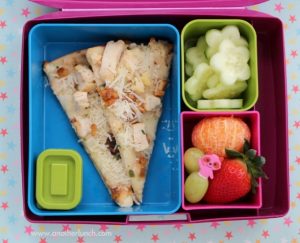
Food brought from home, should be labeled with the child’s name and date and stored in the refrigerator when needed. When prepared and served to children it is important to follow food safety practices (discussed in the next section of the book). Foods for one child should never be given to another child.[60]
Tips for Supporting Families in Providing Nutritious Food From Home
In the Sweitzer et al (2011) study, parents were interviewed about how early care and education programs could help families provide better nutrition for their children. Here are some tips based on their findings:
· Provide regular written information to families about nutrients and their importance for health
· Provide convenient and affordable recipes and tips for families
· Foster connection and interaction between families through events, support groups, and recipe exchanges
· Consider including nutrition as a topic of workshops for families
· Connect with community resources and local markets to expand opportunities and information for families
· Remember to be budget-friendly with resources and recipes shared[61]
Food Safety
Even the most nutritious, visually appealing, affordable, delicious food won’t keep children healthy if it isn’t stored, prepared, and served safely. Let’s look at recommendations for food safety in early care and education programs based on the California Department of Social Services and Child Care Advocate Program’s Child Care Center Self-Assessment Guide – Safe Food Handling and Preparation: Licensing Requirements and Best Practices.

Safe Shopping
When purchasing food for an early care and education program:
- Do not buy or use meat, poultry, and meat products unless they have been inspected.
- Do not use or buy home-canned food from outside sources, food from dented, rusted, bulging, or leaking cans, or food from cans without labels.
- Do not buy or use raw or non-pasteurized milk or milk products, or non-pasteurized juices.
- Place frozen food and perishables such as meat, poultry, or fish in plastic bags and put them in the shopping cart last.
- Do not buy torn or leaking packages.
- Do not buy foods past “sell-by” or expiration dates.[63]
Storage Before Preparation
To keep foods safe from spoilage and contamination before you prepare them:
- Keep your refrigerator and freezer clean and in safe condition.
- Store soaps, detergents, cleaning compounds, or similar substances away from food supplies to prevent accidental poisoning, potential leakage problems, and contamination. Always keep these substances away from children.
- Do not store pesticides and other similar toxic substances where you store, cook, or prepare food, or where you store kitchen equipment or utensils. Always keep these substances away from children.
- Unpack perishable foods from the car first and put them in the refrigerator right away.
- Keep the refrigerator temperature at 40° F or less, and the freezer at 0° F, to slow the growth of most bacteria and keep them from multiplying.
- Check the temperature of your refrigerator and freezer daily with an appliance thermometer.
- Keep all food stored in the refrigerator and freezer covered, wrapped, stored in airtight containers, or otherwise protected from contamination.
- Wrap raw meat, poultry, and seafood securely to prevent raw juices from contaminating other foods. Store them in the meat drawer or coldest section of the refrigerator or freezer.
- Do not store perishable foods, such as eggs, in the refrigerator door. The temperature of storage bins in the door fluctuates more than the temperature in the cabinet.
- Cook or freeze fresh poultry, fish, ground meat, and mixed meats within 2 days after you buy them. Cook or freeze other beef, veal, lamb, or pork within 3 to 5 days.
- Use the cold storage chart in Table 15.9 for guidelines of how long different food products can be safely stored in the refrigerator and freezer.
- Store food that does not need refrigeration in a way to keep insects and rodents from entering the food. For example, keep storage containers off the floor.
- Store dry, bulk foods that are not in their original, unopened containers off the floor in clean metal, glass, or food-grade plastic containers with tight-fitting covers. Label and date the containers.
- Keep storerooms clean, dry, well ventilated, and cool (about 60° F).
- These storage guidelines for home-refrigerated foods will keep them from spoiling or becoming dangerous to eat. The guidelines for freezer storage are for quality only. Frozen foods remain safe indefinitely.[64]
Table 15.9 – Cold Storage Chart [65]
| Food Product | Refrigerator (40° F) | Freezer (0° F) |
| Eggs
Fresh, in shell Hard-cooked |
3 to 5 weeks 1 week |
Don’t freeze Don’t freeze well |
| Liquid Pasteurized Eggs, Egg Substitute
Opened Unopened |
3 days 10 days |
Don’t freeze well 1 year |
| Deli and Vacuum-Packed Products
Egg, chicken, ham, tuna, and macaroni salads |
3 to 5 days |
Don’t freeze well |
| Hot Dogs
Opened package Unopened package |
1 week 2 weeks |
1 to 2 months 1 to 2 months |
| Luncheon Meat
Open package or deli-sliced Unopened package |
3 to 5 days 2 weeks |
1 to 2 months 1 to 2 months |
| Bacon and Sausage
Bacon Sausage, raw – from pork, chicken, turkey, and beef |
7 days 1 to 2 days |
1 month 1 to 2 months |
| Hamburger and Other Ground Meats
Hamburger ground beef, turkey, veal, pork, lamb, and mixtures of them |
1 to 2 days |
3 to 4 months |
| Fresh Beef, Veal, Lamb, and Pork
Steaks Chops Roasts |
3 to 5 days 3 to 5 days 3 to 5 days |
6 to 12 months 4 to 6 months 4 to 12 months |
| Fresh Poultry
Chicken or turkey, whole Chicken or turkey, pieces |
1 to 2 days 1 to 2 days |
1 year 9 months |
| Seafood
Lean fish (flounder, haddock, halibut, etc.) Fatty fish (salmon, tuna, etc.) |
1 to 2 days 1 to 2 days |
6 to 8 months 2 to 3 months |
| Soups and Stews
Vegetable or meat added |
3 to 4 days |
2 to 3 months |
| Leftovers
Cooked meat or poultry Chicken nuggets or patties Pizza |
3 to 4 days 3 to 4 days 3 to 4 days |
2 to 6 months 1 to 3 months 1 to 2 months |
Preparing
Safe food preparation practices include:
- Keep all kitchen equipment, dishes, and utensils clean and in safe condition.
- Wash dishes and eating and serving utensils in a dishwasher (reach a temperature of 165° F during the washing or drying cycle) or by hand with a sanitizing agent.
- Keep the food preparation area separate from the eating, napping, play, toilet and bathroom areas, and from areas where animals are kept. Never use the food preparation area as a passageway while food is being prepared.
- Make sure that all staff wash their hands before preparing food, serving and eating meals and snacks, and after toileting, diapering, and outdoor activities. The best way to combat the spread of communicable disease or germs is by careful handwashing with liquid soap, rinsing under running water, and drying with paper towels.
- Do not wash hands in food preparation sinks to prevent contamination of food.
- Keep all surfaces that come in contact with food (including tables and countertops), floors, and shelving in good repair. Use smooth and nonporous materials that are easily cleaned and sanitized.
- Use cutting boards that can be disinfected (such as glass, Formica, or plastic). Always clean them with soap and hot water after each use.
- Do not use cutting boards with crevices and cuts because they can hide food material that can grow bacteria and contaminate the next food cut on the surface.

- Always clean and sanitize cutting boards, knives, and other utensils after they come in contact with raw meat, poultry, and seafood. Use one cutting board for raw meat products and another for salads and ready-to-eat foods to prevent cross-contamination of bacteria from one food to another.
- Air-dry hand-washed dishes to eliminate recontamination from hands or towels.
- Use dishes with smooth, hard-glazed surfaces that do not have cracks or chips.
- Clean and sanitize table surfaces before and after use.
- Sanitize kitchen dishcloths and sponges often because these materials can hide bacteria and promote their growth.
- Wash kitchen towels and cloths often in hot water in the washing machine.
- Clean the can opener blade after each use.
- Keep garbage in a covered container, away from children. Empty the garbage every day to reduce odors, control insects and rodents, and protect children and the child care center from contamination.
- Occasionally sanitize the kitchen sink, drain, disposal, and connecting pipe by pouring a solution of one teaspoon of chlorine bleach in one quart of water or a commercial cleaning solution down the drain.
- Wash fresh fruits and vegetables with water, and soap and scrub brush when needed, to reduce or eliminate any pesticides or residues.
- Do not allow infants and toddlers in the food preparation area to protect them from kitchen hazards.[67]
Thawing
To protect against foodborne illness, follow the following practices when thawing frozen foods
- Do not thaw meat, poultry, and fish products on the counter or sink because harmful bacteria can grow at room temperature.
- Thaw food in the refrigerator or microwave oven.
- Immediately cook food thawed in the microwave.
- Use defrosted food (cooked or frozen) within 1 to 2 days.[68]
Cooking
Foods must be cooked at high enough temperatures and for long enough to kill any possible microorganisms they may be contaminated with. Here are some general guidelines
- Never serve raw or slightly cooked eggs. Cook eggs until the white is firm and the yolk begins to harden. Substitute pasteurized eggs for raw eggs if sampling homemade dough, cake batter, or eating other foods made with raw eggs such as ice cream, mayonnaise, and eggnog.
- Use a meat thermometer to determine the temperature in the thickest part of the meat.[69] Cook all food to these minimum internal temperatures provided in Table 15.8 as measured with a food thermometer before removing food from the heat source. For reasons of personal preference, consumers may choose to cook food to higher temperatures.[70]
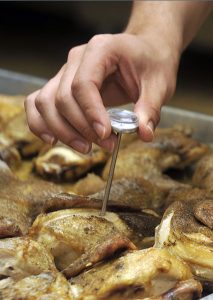
Table 15.8 – Safe Minimum Internal Temperature Chart [71]
| Food Product | Minimum Internal Temperature (F) & Rest Time |
| Ground meats | 160° |
| Beef, Pork, Veal & Lamb Steaks, chops, roasts | 145° and allow to rest for at least 3 minutes |
| Ham, fresh or smoked (uncooked) | 145° and allow to rest for at least 3 minutes |
| Fully Cooked Ham (to reheat) | Reheat cooked hams packaged in USDA-inspected plants to 140 °F; all others to 165 °F |
| All Poultry (breasts, whole bird, legs, thighs, and wings, ground poultry, and stuffing) |
165°
|
| Eggs | 160° |
| Fish & Shellfish | 145° |
| Leftovers, to reheat | 165° |
| Leftovers | 165° |
Food Service
To continue to protect against foodborne illness and prevent injury, food must be served following food safety guidelines, including:
- Keep hot foods hot (over 140° F) and cold food cold (under 40° F) until they are eaten or cooked.
- Carry perishable picnic food in a cooler with a cold pack or ice. Store the cooler in the shade and open it as little as possible.
- Do not leave cooked, perishable foods, including hot foods such as soups or sauces, out for more than two hours after cooking (one hour in temperatures over 90° F). The bacteria that cause foodborne illness grow rapidly at room temperature.
- Never offer foods that are round, hard, small, thick and sticky, smooth, or slippery to children under four years of age because they can cause choking. Hot dogs (sliced into rounds), whole grapes, hard candy, nuts, seeds, raw peas, dried fruit, pretzels, chips, peanuts, popcorn, marshmallows, spoonfuls of peanut butter, and chunks of meat, which are larger than can be swallowed whole are examples of foods that can cause choking.
- Cut food into small pieces for infants (¼ inch) and toddlers (½ inch).
- Do not use microwave ovens for warming infant bottles and infant food because the microwave can heat liquids or food unevenly and to scalding temperatures. The milk or formula in a microwaved bottle may reach a higher temperature than the outside of the bottle.[72]
Handling Leftovers
All food that has been served to children must be discarded after the meal or snack. If a program chooses to save food that has not been served to children, follow these guidelines:
- Divide large amounts of leftovers (for example, large cuts of meat or poultry) into smaller portions and place them in shallow containers before refrigerating for faster cooling.
- Use refrigerated leftovers within three to four days or discard them.
- Bring sauces, soups, and gravy to a boil when reheating. Heat other leftovers to 165° F.[73]
Pause to Reflect
 |
What are some new things you learned about food safety? Do you have any questions about food safety that weren’t addressed in this section? If so, where could you find answers to them? |
Summary
When staff in early care and education programs have an understanding of the CACFP meal patterns and health sources for all of the food groups, they have the foundation to plan menus that consider cost, variety, aesthetics, and balance. They can also support families in providing healthy food to their children. And with a solid grounding in food safety policies and practices they can buy, store, prepare, cook, and serve food to children safely.
Chapter 15 Review
Resources for Further Exploration
· Institute of Child Nutrition: https://theicn.org/
· Minnesota Department of Education CACFP Meal Patterns Resources: https://education.mn.gov/MDE/dse/FNS/prog/CACFPCen/
· Virtual Lab School Menu Planning for Success: https://www.virtuallabschool.org/focused-topics/food-service/lesson-1
· CACFP Meal Pattern Guidelines and Resources: https://healthykidshealthyfuture.org/cacfp/
· Cultural and Ethnic Food and Nutrition Education Materials: A Resource List for Educators: www.nal.usda.gov/sites/default/files/fnic_uploads/ethnic.pdf
· Guidance on Foods for Religious Faiths: https://www.publichealth.hscni.net/sites/default/files/FaithsPosterA2.pdf
· Vegetarianism and Children: https://www.nal.usda.gov/fnic/vegetarianism-and-children
· Virtual Lab School Family-Style Dining in Child Care Settings: https://www.virtuallabschool.org/focused-topics/food-service/lesson-2
· Federal Food Safety Gateway: www.foodsafety.gov
· CDC Food Safety: https://www.cdc.gov/foodsafety/
· Food Buying Guide for Child Nutrition Programs Interactive Web-Based Tool: https://foodbuyingguide.fns.usda.gov/
Chapter 15 Workbook
References:
[1] Updated Child and Adult Care Food Program Meal Patterns: Infant Meals by the USDA Child and Adult Care Food Program is in the public domain
[2] Updated Child and Adult Care Food Program Meal Patterns: Child and Adult Meals by the USDA Child and Adult Care Food Program is in the public domain
[3] Image by the USDA Food and Nutrition Service is in the public domain
[4] Image by the USDA Food and Nutrition Service is in the public domain
[5] Image by the USDA Food and Nutrition Service is in the public domain
[6] Updated Child and Adult Care Food Program Meal Patterns: Infant Meals by the USDA Child and Adult Care Food Program is in the public domain
[7] Updated Child and Adult Care Food Program Meal Patterns: Child and Adult Meals by the USDA Child and Adult Care Food Program is in the public domain
[8] Image by the USDA Food and Nutrition Service is in the public domain
[9] Image by the USDA Food and Nutrition Service is in the public domain
[10] Image by the USDA Food and Nutrition Service is in the public domain
[11] Updated Child and Adult Care Food Program Meal Patterns: Infant Meals by the USDA Child and Adult Care Food Program is in the public domain
[12] Updated Child and Adult Care Food Program Meal Patterns: Child and Adult Meals by the USDA Child and Adult Care Food Program is in the public domain
[13] Child and Adult Care Food Program: Best Practices by the USDA Child and Adult Care Food Program is in the public domain
[14] Image by the USDA Food and Nutrition Service is in the public domain
[15] Image by the USDA Food and Nutrition Service is in the public domain
[16] Image by the USDA Food and Nutrition Service is in the public domain
[17] Introduction to Food Production and Service by Beth Egan is licensed under CC BY 4.0
[18] Introduction to Food Production and Service by Beth Egan is licensed under CC BY 4.0
[19] Foundations for Assisting in Home Care by Kimberly B. McLain, Erin K. O’Hara-Leslie, and Andrea C. Wade is licensed under CC BY 4.0
[20] Introduction to Food Production and Service by Beth Egan is licensed under CC BY 4.0
[21] Virtual Lab School. (n.d.). Essentials in child care food service: Menu planning for success. Virtual Lab School. Retrieved from https://www.virtuallabschool.org/focused-topics/food-service/lesson-1
[22] Foundations for Assisting in Home Care by Kimberly B. McLain, Erin K. O’Hara-Leslie, and Andrea C. Wade is licensed under CC BY 4.0
[23] All about the Dairy Group by the USDA Center for Nutrition Policy and Promotion is in the public domain
[24] Dairy Products by Marco Verch is licensed under CC BY 2.0
[25] Foundations for Assisting in Home Care by Kimberly B. McLain, Erin K. O’Hara-Leslie, and Andrea C. Wade is licensed under CC BY 4.0
[26] MyPlate Tips for Preschoolers by the USDA Center for Nutrition Policy and Promotion is in the public domain
[27] All about the Protein Foods Group by the USDA Center for Nutrition Policy and Promotion is in the public domain
[28] Protein-Rich Foods by Smastronardo is licensed under CC BY-SA 4.0
[29] Foundations for Assisting in Home Care by Kimberly B. McLain, Erin K. O’Hara-Leslie, and Andrea C. Wade is licensed under CC BY 4.0
[30] MyPlate Tips for Preschoolers by the USDA Center for Nutrition Policy and Promotion is in the public domain
[31] All About the Fruit Group by the USDA Center for Nutrition Policy and Promotion is in the public domain
[33] Foundations for Assisting in Home Care by Kimberly B. McLain, Erin K. O’Hara-Leslie, and Andrea C. Wade is licensed under CC BY 4.0
[34] MyPlate Tips for Preschoolers by the USDA Center for Nutrition Policy and Promotion is in the public domain
[35] All about the Vegetable Group by the USDA Center for Nutrition Policy and Promotion is in the public domain
[36] Image by Sven Hilker on Pixabay
[37] Foundations for Assisting in Home Care by Kimberly B. McLain, Erin K. O’Hara-Leslie, and Andrea C. Wade is licensed under CC BY 4.0
[38] MyPlate Tips for Preschoolers by the USDA Center for Nutrition Policy and Promotion is in the public domain
[39] Child and Adult Care Food Program: Best Practices by the USDA Child and Adult Care Food Program is in the public domain
[40] All about the Grains Group by the USDA Center for Nutrition Policy and Promotion is in the public domain
[42] Foundations for Assisting in Home Care by Kimberly B. McLain, Erin K. O’Hara-Leslie, and Andrea C. Wade is licensed under CC BY 4.0
[43] MyPlate Tips for Preschoolers by the USDA Center for Nutrition Policy and Promotion is in the public domain
[44] Child and Adult Care Food Program: Best Practices by the USDA Child and Adult Care Food Program is in the public domain
[45] Foundations for Assisting in Home Care by Kimberly B. McLain, Erin K. O’Hara-Leslie, and Andrea C. Wade is licensed under CC BY 4.0
[46] Child and Adult Care Food Program: Best Practices by the USDA Child and Adult Care Food Program is in the public domain
[47] Food and Drink Prohibitions by Wikipedia is licensed under CC BY-SA 3.0
[48] Nutritional Guidance for Early Years: Food Choices for Children Aged 1-5 Years in Early Education and Childcare Settings by the Scottish Government is licensed under Open Government License Version 3
[49] Except as noted, text comes from Nutritional Guidance for Early Years: Food Choices for Children Aged 1-5 Years in Early Education and Childcare Settings by the Scottish Government, which is licensed under Open Government License Version 3
[50] Seventh-Day Adventist Church by Simple English Wikipedia is licensed under CC BY-SA 3.0
[51] Culture of The Church of Jesus Christ of Latter-day Saint by Wikipedia is licensed under CC BY-SA 3.0
[53] Vegetarian Diet by MedlinePlus is in the public domain
[54] Results from an Experimental Trial at a Head Start Center To Evaluate Two Meal Service Approaches to Increase Fruit and Vegetable Intake of Preschool Aged Children by Lisa J. Harnack, J. Michael Oakes, Simone A. French, Sarah A. Rydell, Farhiyah M. Farah, and Gretchen L. Taylor is licensed under CC BY 2.0 https://ijbnpa.biomedcentral.com/articles/10.1186/1479-5868-9-51
[55] Image by the National CACFP Sponsors Organization as appears on hhs.gov is in the public domain.
[56] Why You Should Serve Family Style by the National CACFP Sponsors Organization as appears on hhs.gov is in the public domain.
[57] Why You Should Serve Family Style by the National CACFP Sponsors Organization as appears on hhs.gov is in the public domain.
[58] Sweitzer, S. J., Briley, M. E., Roberts-Gray, C., Hoelscher, D. M., Staskel, D. M., & Almansour, F. D. (2011). How to help parents pack better preschool sack lunches: advice from parents for educators. Journal of nutrition education and behavior, 43(3), 194–198. https://doi.org/10.1016/j.jneb.2010.09.002
[59] Pizza School Lunch – Laptop Lunches for Kindergarten Bento Box by Melissa is licensed under CC BY 2.0
[60] Child Care Center Self Assessment Guide: Safe Food Handling and Preparation
Licensing Requirements and Best Practices by the California Department of Social Services Community Care Licensing Division is in the public domain
[61] Sweitzer, S. J., Briley, M. E., Roberts-Gray, C., Hoelscher, D. M., Staskel, D. M., & Almansour, F. D. (2011). How to help parents pack better preschool sack lunches: Advice from parents for educators. Journal of nutrition education and behavior, 43(3), 194–198. https://doi.org/10.1016/j.jneb.2010.09.002
[62] School Age Annex Reopens by Kenji Thuloweit is in the public domain
[63] Child Care Center Self Assessment Guide: Safe Food Handling and Preparation
Licensing Requirements and Best Practices by the California Department of Social Services Community Care Licensing Division is in the public domain
[64] Child Care Center Self Assessment Guide: Safe Food Handling and Preparation
Licensing Requirements and Best Practices by the California Department of Social Services Community Care Licensing Division is in the public domain
[65] Cold Food Storage by the USDA Food Safety and Inspection Service is in the public domain
[67] Child Care Center Self Assessment Guide: Safe Food Handling and Preparation
Licensing Requirements and Best Practices by the California Department of Social Services Community Care Licensing Division is in the public domain
[68] Child Care Center Self Assessment Guide: Safe Food Handling and Preparation
Licensing Requirements and Best Practices by the California Department of Social Services Community Care Licensing Division is in the public domain
[69] Child Care Center Self Assessment Guide: Safe Food Handling and Preparation
Licensing Requirements and Best Practices by the California Department of Social Services Community Care Licensing Division is in the public domain
[70] Safe Minimum Internal Temperature Chart by the USDA Food Safety and Inspection Service is in the public domain
[71] Safe Minimum Internal Temperature Chart by the USDA Food Safety and Inspection Service is in the public domain
